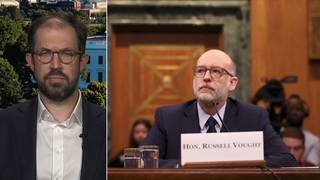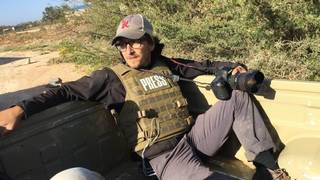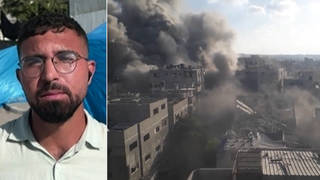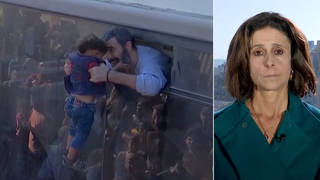
Guests
- Jawanza Williamsdirector of organizing at VOCAL-New York.
- Lorenzo Larocviolinist and composer who knew Jordan Neely for 20 years when they were both buskers in the New York City subway system.
We continue our look at calls for justice for Jordan Neely, a 30-year-old unhoused Black man who was choked to death on a subway car last week by another passenger. Jordan Neely was crying out that he was hungry, when he was fatally attacked on the train by a 24-year-old former marine named Daniel Penny. Penny was interviewed by police detectives but has not been arrested. Before he fell on hard times, Neely was well known to New Yorkers and tourists as a talented Michael Jackson impersonator. We speak with Jawanza Williams, the director of organizing at VOCAL-New York, about the crisis facing the city’s growing unhoused population, the need for affordable rent, opposition to Mayor Eric Adams’s austerity budget, and calls for Governor Kathy Hochul to stop blocking progressive policy in Albany. We also speak with Lorenzo Laroc, who knew Jordan Neely for 20 years when they were both buskers in the New York City subway system. “What was ironic is that those trains are where he made a living,” said Laroc. “It’s like getting killed at your jobsite.”
Transcript
AMY GOODMAN: This is Democracy Now!, democracynow.org, The War and Peace Report. I’m Amy Goodman, as we bring you Part 2 of our look at calls for justice for Jordan Neely, the 30-year-old unhoused Black man who was choked to death on a subway car last week by another passenger. Jordan Neely was crying out that he was hungry and thirsty, when he was fatally attacked on the train by a 24-year-old former marine named Daniel Penny. Penny was interviewed by police detectives, but he was then released. He has not been arrested — unlike many people who have been protesting, calling for his arrest and calling for justice. Before Jordan Neely fell on hard times, he was well known to New Yorkers and tourists as a talented Michael Jackson impersonator who made a living in Times Square and on New York subways.
For more, we’re joined by two guests. Jawanza Williams is the director of organizing at VOCAL-New York, and Lorenzo Laroc, who knew Jordan nearly for decades when they were both buskers in the New York City system.
We welcome you both to Democracy Now! Thank you for staying with us. Jawanza, if you can talk about the situation for the growing unhoused population in the city, how they’re dealt with, and if you can talk about the response by the city to the demands by protesters that Daniel Penny, the ex-marine who put Jordan Neely in a chokehold — and we have to add that he was held down by two other passengers, as well, and when others went to try to help, they were pushed away. Respond.
JAWANZA WILLIAMS: First of all, I think what we’re seeing with the police response to, you know, amendment-protected democratic rights of free assembly and public protest, we’re seeing more of the same. Like, every time that anything happens in the city where progressive people, conscientious people, people with a heart, stand up and demand justice, the state responds with violence, with the mobilization of violence through the NYPD. So I’m not shocked or surprised at all by that crackdown.
But it does remind us of the contradictions that Democratic leadership, like Kathy Hochul, Governor Kathy Hochul, and Mayor Eric Adams, have been espousing for the last couple of years in the city of New York, especially as it relates to people experiencing homelessness and people who have mental health complexities. So, I would say, number one, people need to understand that the homelessness and housing crisis in the city of New York is affecting scores and scores of people, including children. In the last seven years in a row in the city of New York, according to the Department of Education, 100,000 students go to school from a shelter at some point throughout the year. Yet you will never actually hear that being the focus of conversation when it comes to the state budget, which was just negotiated and was over a month late. And the measures that were most important to people like Jordan Neely in New York City and other people experiencing homelessness, like Daniel’s Law, like the housing access voucher program, like the retention of, you know, cashless bail, all of these things are missing. You know, the governor was able to roll back bail by using the same kind of narrative and framework that the GOP has been using across the country, this fearmongering, this, you know, “no one’s safe” sort of narrative, especially about people experiencing homelessness in the subways in New York City. And they’ve been able to win, you know, these kinds of arguments.
And I think that the fact is, we need to refocus about what are the structural phenomena that’s taking place that leads a person to be experiencing homelessness, chronic homelessness. And also, the criminalization of homelessness, this is about that, as well. It’s about the, you know, delegitimate mobilization of police, because the police did not generate and maintain safety in the subways, not for Jordan Neely, who was strangled to death. So, I think that what we need to see happen is the city to respond in its budget negotiations in such a way that responds to — you know, in an antiracist way, in a class-conscious way, in a gender-expansive way. So what that really looks like and what it really means is the kinds of policy platforms that progressive organizations and progressive communities have been calling for, like the People’s Plan New York, like the Housing Justice for All Campaign, like VOCAL-New York’s Homelessness Union. We’ve been trying to offer to the city of New York and to the City Council, you know, the kinds of roadmaps that we need. That means safe haven beds, rapid rehousing. We need people to make sure that they’re able to, you know, avoid source-of-income discrimination, which plagues the city. And the Commission on Human Rights and its Source of Income Discrimination Unit needs to be fully funded and fully staffed. It needs not two, three, four attorneys; it needs 10, 20, 30 attorneys to be able to prosecute landlords that are engaging in discriminatory practices that continues to keep people homeless and expand the number of people experiencing homelessness.
And finally, I’ll say, Amy, the Rent Guidelines Board voting — or, planning to vote to expand on the cost of rent in New York City is entirely out of step with the reality that I’m naming, where tens of thousands of people are at risk of homelessness imminently, and 100,000-plus people across the state of New York and 100,000 people really in the city of New York are experiencing homelessness, and they need secure and stable housing. And at the core, that means affordable rent.
AMY GOODMAN: I wanted to ask Lorenzo Laroc about the effect of the pandemic on performers, on artists, and if you can talk about whether you think this impacted Jordan himself, and the fact that he was clearly suffering from a mental health crisis. I mean, the independent journalist who took out his cellphone and was filming what happened said that he didn’t pose a violent threat to anyone, and he was right there in the car, who filmed him.
LORENZO LAROC: Well, like I said earlier, I’ve known Jordan for 20 years, and we worked together down in the subway system. And never once in those 20 years have I seen him aggressive, have a problem with anyone. He was a consummate professional artist.
The pandemic was devastating to the artistic community, especially with people who made a living daily in the trench. Jordan made an honest living, giving love and his art to this city. And, you know, unfortunately, artists fell by the wayside during the pandemic. I mean, we were just — you know, I do weddings and bar mitzvahs also for a living. That stopped completely. The subways were shut down. I mean, you know, if you’re living — if you’re dancing or playing violin for your dinner, you know, and then the world just shuts down — it was the first time in my 40-year career I had been unemployed for two years straight. And I have two teenage daughters. You know, Jordan was in a crisis, like many — I know many musicians and artists here in the city. After the pandemic, they left New York. They just couldn’t survive here, couldn’t afford it. And a lot of people were homeless. I mean, I had to move. You know, it was just — it was devastating.
AMY GOODMAN: I wanted to read a quote from Jordan’s family. He had been going through so much. Donte Mills, an attorney for Jordan’s family, said Neely had demons as a result of — well, his mother was murdered back in, what, 2008, 2007, 2009. His family was trying to get him help. He said, “We all know people who are on the brink of going through something major, a catastrophe where they just can’t seem to get everything back together, and that’s where he was. But he had a life that he was living and was reaching for.”
Jawanza, you mentioned in Part 1 of our conversation, Daniel’s Law, that didn’t get passed, and your group, VOCAL-New York, was pushing for that, the law named for Daniel Prude, the Black man killed by Rochester police in March of 2020 when he was having a mental health crisis. I believe his brother called for help. Daniel Prude died from asphyxiation after the Rochester police officers handcuffed him while he was naked, put a hood over his head, pushed his face into the freezing cold ground for two minutes while kneeling on his back. And last year a grand jury decided not to file charges against the officers involved in his death. Can you talk about what happened to this legislation?
JAWANZA WILLIAMS: So, the thing is, the governor has been playing this conservative tune ever since she was, you know, appointed governor and then elected governor. And basically, every time the right-wing conservative media and neoliberal media talks about anything to do with bail reform or anything to do with, you know, reducing the carceral state, there’s this fearmongering that’s kicked up. So, this bill was, essentially, I believe, dead on arrival.
I can’t speak to the details of the campaign. You’d have to talk to folks like Keli Young, who’s our civil rights campaigns coordinator, who really understands the intricate, you know, facts that happened in that fight in Rochester. But what I can say is that we cannot win progressive public policy if we’re up against frameworks of reality that are rooted in a disreality, in anti-Black racism, in classism. We can’t really begin to have a conversation about mental health complexities, if everybody wants to deputize themselves a psychologist or as someone who’s able to render those kinds of services, and, therefore, write that kind of public policy. But the fact is, most people are not. And there are organizations, there are people, there are healthcare professionals, who know how to handle people with mental healthcare complexities. And the fact is, these are evidence-based responses and practices. And they don’t exist because the political will is not there. And we don’t have the political or economic resources to be able to build that infrastructure. And every time we try to do that, like through Daniel’s Law, we have to fight against politics of austerity, politics of racism and fear.
AMY GOODMAN: And, Lorenzo Laroc, you’re born and bred in Harlem. You’re a street performer and subway performer for decades. On Friday, you spoke at a protest calling for the Manhattan DA Alvin Bragg to prosecute Daniel Penny for killing Jordan Neely. Talk about what you think has to happen more.
LORENZO LAROC: Well, you know, as an artist and as a New Yorker, you know, Jordan, to me, was what — was the best parts of this city. You know, he gave freely to this, to my city, you know, his talents and his joy. What I witnessed was basically — I felt like all artists were being murdered right there, because he — especially what was ironic is, those trains were where he made a living. It’s like getting killed at your jobsite.
AMY GOODMAN: “Like getting killed at your jobsite.” Lorenzo Laroc, I want to thank you so much for being with us. You knew Jordan Neely for 20 years, when they were both buskers, street performers, in the New York City subway system. Lorenzo, classically trained electric violinist and composer who plays a custom-made five-string plexiglass electric violin and viola, born, raised, educated and lives in Harlem. Jawanza Williams, director of organizing at VOCAL-New York. And as the protests continue, we continue to cover this story. To see Part 1 of our discussion, go to democracynow.org. I’m Amy Goodman. Thanks so much for joining us.











Media Options